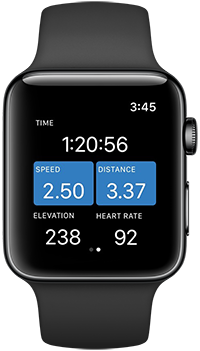Apple Watch interface

As of version 2.5, Elevation Tracker includes an Apple Watch app that you can use to display real-time stats and track heart rate. Here are some details:
- You need iOS 9.3 or later on your iPhone.
- You can start tracking from the phone app or the watch app. If you start from the phone, the watch app will come to the foreground automatically. If you start from the watch, the phone app will start running in the background.
- You can also stop tracking from the phone app or the watch app. If you stop from the phone, you can enter a name for your route. If you stop from the watch, the route will be saved with a default name, but you can rename it in the phone app later.
- When you use Elevation Tracker with an Apple Watch, it will add a workout to the Activity app on your phone, even if you reset your route instead of saving it. If needed, you can delete this workout from the Activity app.
- The watch app will use the heart rate from the Apple Watch's built-in sensor if you don't have a Bluetooth heart rate monitor connected. Bluetooth heart rate monitors typically update more often, so Elevation Tracker will use the Bluetooth signal if available. If you start using a Bluetooth HRM but it becomes disconnected, Elevation Tracker will automatically fall back to the Apple Watch sensor, then resume using the Bluetooth if it reconnects. A small Bluetooth icon will appear next to the heart rate display when the app is using a Bluetooth HRM.
- The watch app will update its display whenever the phone app updates its display, but the displays only update when you have moved 10 meters. This means the timer won't necessarily show every second that passes, but it will still show the correct time at the next update.
- If you add the Elevation Tracker complication to your watch face, the watch app will launch faster.
- If you no longer wish to use the watch app, you can uninstall it. No data is stored on the watch, and you can always install it again later.








